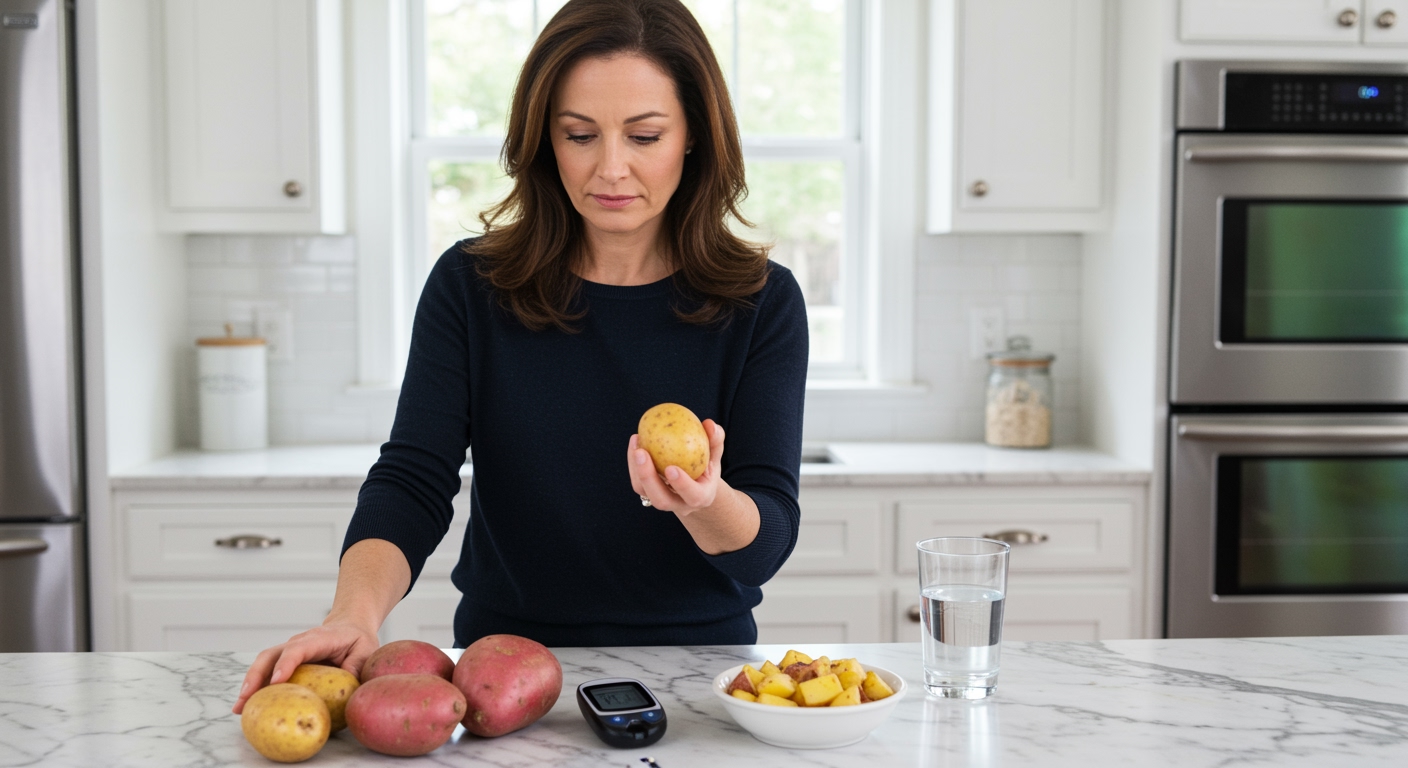✪ Key Takeaway: Potatoes can be part of a diabetes-friendly diet when prepared properly and eaten in controlled portions.
Introduction
You walk down the grocery store aisle and see those beautiful potatoes calling your name.
But then that voice in your head whispers the same warning you have heard countless times: potatoes will spike your blood sugar and make your diabetes worse.
Hi, I am Abdur, your nutrition coach and today I am going to explain the real truth about potatoes and diabetes so you can make informed decisions about this nutritious vegetable.
Do Potatoes Really Spike Blood Sugar?
The answer depends on several factors that most people never consider.
Potatoes contain carbohydrates that your body breaks down into glucose, which enters your bloodstream and raises blood sugar levels.
However, the glycemic response varies dramatically based on the type of potato, cooking method, and what you eat with it.
Research shows that a medium baked russet potato has a glycemic index of around 85, which is considered high.
But when you cool that same potato and eat it the next day, something fascinating happens: the resistant starch content increases significantly.
This resistant starch acts more like fiber in your digestive system, causing a much slower blood sugar rise compared to freshly cooked potatoes.
✪ Fact: Cooling cooked potatoes overnight can reduce their glycemic impact by up to 25 percent.
Which Potato Types Are Best For Diabetes?
Not all potatoes affect your blood sugar the same way.
Sweet potatoes generally have a lower glycemic index than regular potatoes, typically ranging from 45 to 65 depending on preparation.
The fiber content in sweet potatoes helps slow down glucose absorption, making them a better choice for blood sugar management.
Red potatoes and new potatoes also tend to have a lower glycemic response compared to russet potatoes.
This difference occurs because smaller, waxy potatoes contain less starch and more moisture than large, starchy varieties.
Purple potatoes deserve special mention because they contain anthocyanins, powerful antioxidants that may help improve insulin sensitivity.
✪ Pro Tip: Choose smaller, colorful potato varieties over large russet potatoes for better blood sugar control.
How Should You Cook Potatoes For Diabetes?
The cooking method you choose makes a huge difference in how potatoes affect your blood sugar.
Boiling potatoes typically results in a lower glycemic response compared to baking or frying.
When you boil potatoes, some of the starch leaches into the cooking water, reducing the overall carbohydrate content.
Steaming produces similar results while preserving more nutrients compared to boiling.
Avoid deep-frying potatoes because the high heat and oil create a combination that can cause rapid blood sugar spikes.
If you love baked potatoes, try this trick: bake them, let them cool completely, then reheat before eating to increase the resistant starch content.
Adding healthy fats like olive oil or eating potatoes with protein can also help slow glucose absorption and reduce blood sugar spikes.
✪ Note: Always eat potato skin when possible as it contains valuable fiber and nutrients that help moderate blood sugar.
What Is The Right Portion Size?
Portion control becomes critical when you have diabetes and want to include potatoes in your diet.
A safe serving size is typically one small potato or about half a cup of diced cooked potatoes.
This portion contains approximately 15 grams of carbohydrates, which equals one carbohydrate exchange in diabetes meal planning.
Many people make the mistake of eating restaurant-sized portions, which can contain 60 grams of carbohydrates or more.
Your individual carbohydrate tolerance may vary, so monitor your blood sugar levels after eating potatoes to determine your personal response.
Consider using a food scale initially to understand what appropriate portions look like on your plate.
Remember that potatoes should be part of a balanced meal that includes protein, healthy fats, and non-starchy vegetables.
✪ Pro Tip: Fill half your plate with non-starchy vegetables when eating potatoes to balance the meal and slow glucose absorption.
Can Potatoes Actually Benefit People With Diabetes?
Surprisingly, potatoes offer several nutrients that can support overall health when you have diabetes.
They provide significant amounts of potassium, which helps regulate blood pressure and supports heart health.
Since people with diabetes have higher risks of cardiovascular disease, maintaining healthy blood pressure becomes especially important.
Potatoes also contain vitamin C, vitamin B6, and magnesium, all nutrients that play roles in glucose metabolism and immune function.
The fiber in potato skin helps promote digestive health and may contribute to better blood sugar control over time.
Recent research suggests that completely avoiding potatoes may not be necessary for diabetes management when they are prepared and portioned appropriately.
The key lies in making potatoes part of a well-planned, nutrient-dense diet rather than eating them in isolation or in excessive amounts.
✪ Fact: One medium potato with skin provides about 20 percent of your daily potassium needs.
The Bottom Line
Potatoes do not have to be completely off-limits when you have diabetes, but they require thoughtful preparation and portion control.
Smart food choices are about balance and preparation, not complete elimination, and this principle applies perfectly to potatoes in a diabetes-friendly diet.
I would love to hear about your experiences with potatoes and blood sugar management, so please share your questions or thoughts in the comments below.
References
At NutritionCrown, we use quality and credible sources to ensure our content is accurate and trustworthy. Below are the sources referenced in creating this article:
- WebMD: Carbs, Potatoes, and Blood Sugar
- PMC: Potato Consumption and Risk of Type 2 Diabetes
- Healthline: Potatoes and Diabetes
- Australian Catholic University: Potatoes Do Not Need to Be Off Limits for Type 2 Diabetes





